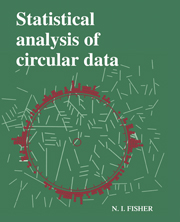Book contents
- Frontmatter
- Contents
- Preface to the first paperback edition
- Preface
- 1 Introduction
- 2 Descriptive methods
- 3 Models
- 4 Analysis of a single sample of data
- 5 Analysis of two or more samples, and of other experimental layouts
- 6 Correlation and regression
- 7 Analysis of data with temporal or spatial structure
- 8 Some modern statistical techniques for testing and estimation
- Appendix A Tables
- Appendix B Data sets
- References
- Index
7 - Analysis of data with temporal or spatial structure
Published online by Cambridge University Press: 03 May 2011
- Frontmatter
- Contents
- Preface to the first paperback edition
- Preface
- 1 Introduction
- 2 Descriptive methods
- 3 Models
- 4 Analysis of a single sample of data
- 5 Analysis of two or more samples, and of other experimental layouts
- 6 Correlation and regression
- 7 Analysis of data with temporal or spatial structure
- 8 Some modern statistical techniques for testing and estimation
- Appendix A Tables
- Appendix B Data sets
- References
- Index
Summary
Introduction
We shall be concerned with three types of data in this chapter:
(I) Circular observations in relation to a time sequence t1,t2,…
(II) Circular observations in relation to a one-dimensional spatial sequence x1,x2,…, in other words a sequence of points along a line.
(III) Circular observations in relation to a corresponding set of two-dimensional spatial locations, in other words positions in the plane.
Time-dependent sequences of data of type I arise commonly in Meteorology and Oceanography as measurements of wind or current direction at a particular location; often, but not always, each direction has an associated measurement of strength, so that the data constitute velocities. When the measurements have been recorded at equal intervals (e.g. hourly or daily measurements of wind direction), the sequence is called a time series. Typically, the questions of interest relate to finding models which capture a sufficient amount of the dependence structure to allow future behaviour of the series to be predicted.
Data sequences gathered along a line (type II) can occur in Structural Geology, for example, when mapping along a mining tunnel. Here, interest centres on extracting an overall trend, or detecting sudden changes in the general trend of the sequence. Data of this type differ from those of type I in that they can be looked at in reverse order – the order depended simply on the direction x1,x2,… or xn,xn-1,… used for sampling – whereas time-ordered sequences usually have only one sensible direction.
- Type
- Chapter
- Information
- Statistical Analysis of Circular Data , pp. 169 - 198Publisher: Cambridge University PressPrint publication year: 1993



